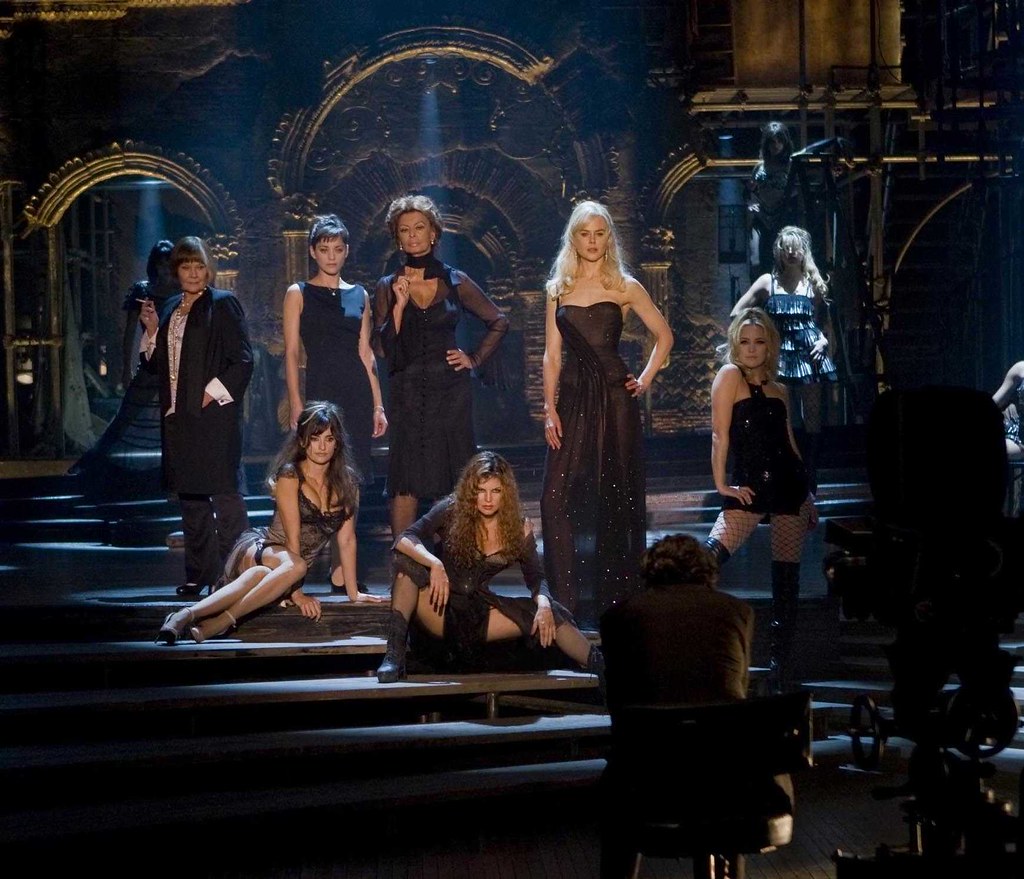Translation is everything. Just as prosody, if even if you didn’t know the language nor had any clue of the meaning of the words, Otto E Mezzo manifests a concision, balance & exactness that is flat out gorgeous. So much to be conveyed with just five letters. Brought over from the Italian into English, the title of the great film by Federico Fellini looks off-balance & awkward: 8½. The film is the dreamlike tale of a famous director, Marcello Mastroianni in his canonical role as Guido, a transparent cipher for Fellini himself, who finds himself confronting a horrific case of filmmaker’s block as he sets out to make a new movie. One could argue, no doubt, as to the role of Fellini in the history of Italian cinema, but it would be much harder to contest the fact that 8½ was the apotheosis of Italian film in the 1960s.
Imagine now, if you can, the entire project recast as a British musical with Daniel Day-Lewis in the role of Guido, Marion Cotillard as his long-suffering wife Luisa (originally played by Anouk Aimée), Penélope Cruz as his mistress Carla (Sara Milo in 8½), Nicole Kidman as Claudia (Claudia Cardinale), Fergie as the whore Saraghina (Eddra Gale), plus Sophia Loren, Judi Dench & Kate Hudson in roles that have antecedents in the earlier film, but not precisely as configured here. The result is a very odd concoction, a giant love letter to Federico that isn’t quite willing to take the same risks that made him what he was, and that is being marketed to U.S. film-goers in such a way that, if they don’t already know Fellini, they won’t hear about him here.
Obviously, this is an homage done with much love – the music for Mario Fratti’s original play in Italian was composed by Andrea Guerra, the son of the great Tonino Guerra, the screenwriter who authored virtually all of Antonioni’s greatest films & even Fellini’s Amacord. If young Guerra (he’s been a top composer for Italian TV & film for 20 years) isn’t quite Nino Rota, Fellini’s composer & collaborator, trained right here in Philly at the Curtis Institute, that may be because nobody is Nino Rota. By way of contrast, this is a much better musical qua musical than, say, Baz Luhrmann’s ponderous Moulin Rouge or Chicago, which Nine director Rob Marshall also made.¹
But a musical? If one looked at this project as “let’s do a remake of 8½,” one would not think of a musical, except as a giant concession to contemporary filmgoers who might be unwilling to sit still for the dream-like looseness of Fellini’s original narrative. Sophia Loren – not in the original, incidentally – as the rather omnipresent dead mother, for example. Or the boy who is Guido at the age of nine (one of at least three meanings of that title here²). Not elements that go down all that easily with the literal-minded US audience, unless it’s off chasing Na’vi, hobbits, vampires or he who shall not be named. (Consider the flack Peter Jackson, of all people, is getting for not making the afterlife “real enough” in The Lovely Bones.) And some of 8½’s more nightmarish moments, such as the opening sequence of a man being gassed in his car stuck in traffic while he’s unable to kick his way out & bystanders just look on, are gone altogether here.
As one might imagine with a pastiche like this, the performances are uneven, ranging from the tremendous (Day-Lewis, who was brought in to replace Javier Bardem, who had first signed to play Guido; Dench, who is a revelation in her role & steals this film from all the young stunners in the cast; Cruz, whose role plays a little too close to what she’s done before; and Cotillard, who is just getting started in the English-speaking world, but appears to have no limits) to the okay (Loren, who is required mostly to look like Sophia Loren; or Hudson, whose biggest musical number is so enhanced via rapid jump cuts that it’s not clear if she can really do all that) to the barely undead (Kidman, still the worst actress in Hollywood, tho her “ice queen” Ur-goddess role suits her as it would have Catherine Zeta-Jones, who’d originally signed on to play Claudia). And once you realize what a mish-mash this homage is turning out to be, the performances are what remain to be watched. Which brings it all much closer not to Fellini’s masterpiece but that other autobiographical tale told at least partly through music, Bob Fosse’s All That Jazz.
¹ None of which come even close to John Carney’s Once as a musical, but that low-budget Irish indie did have the advantage of being a musical designed for film & not the stage, plus it had the music of Glen Hansard & Markéta Irglová, who also brought the best screen chemistry to the film since Bogie met Bacall.
² Fellini’s 8½ referred to its placement in his cinematic resume – having made six features, two shorts & a segment in a collaboration previously – as well as winking at the whole notion of cock size. We are told that this is Guido’s ninth collaboration with his producer & there are nine key women in the narrative: the mother, the wife, the mistress, the star, Guido’s confidante who is his costume designer, the whore in young Guido’s past & the reporter who wants to bed him, plus two young actresses who go through screen tests in the next-to-last scene just to keep the count right.






